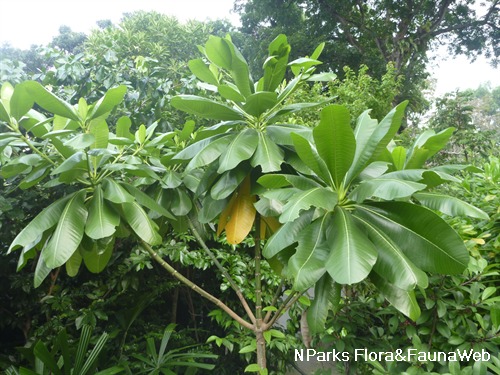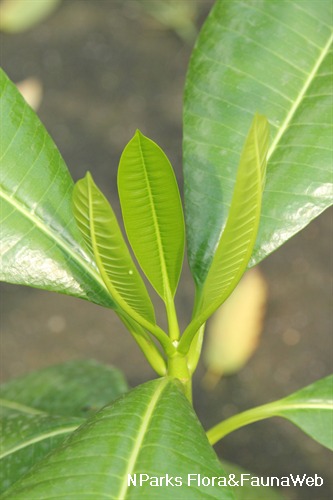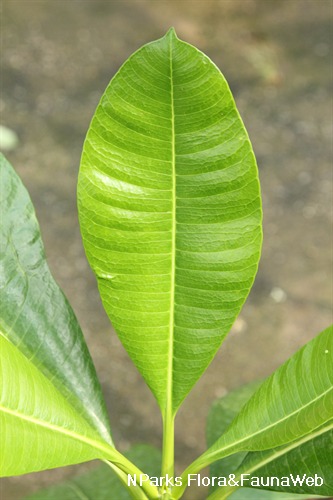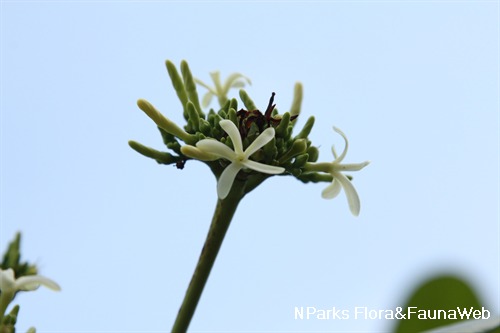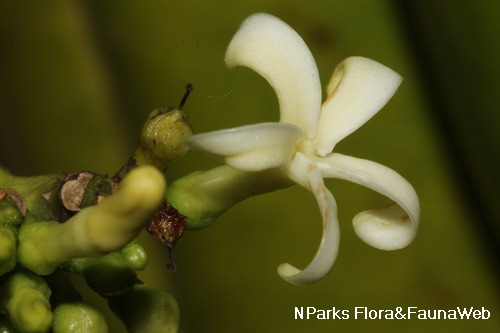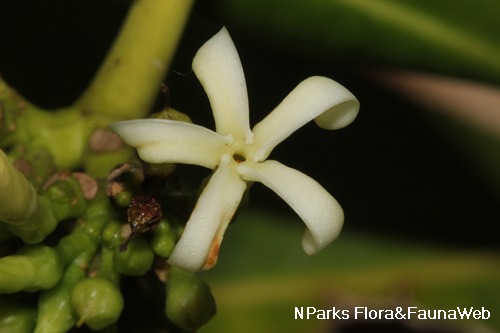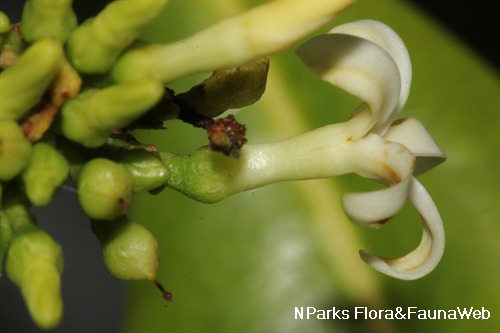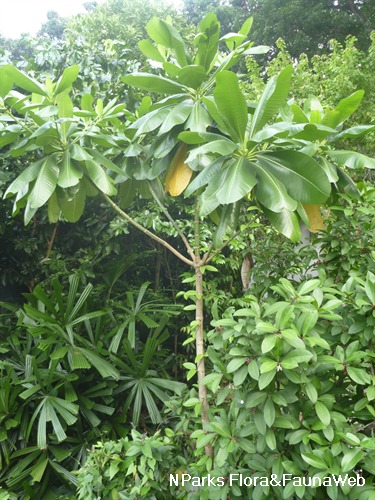
Back
Ochrosia oppositifolia (Lam.) K.Schum.
| Family Name: | Apocynaceae |
| Synonyms: | Cerbera oppositifolia Lam., Neisosperma oppositifolium (Lam.) Fosb. & Sach. |
| Common Name: | Twin-Apple |
Ochrosia oppositifolia or Twin-Apple is a tall tree that can grow to 60 m tall. This native tree exudates a white milky sap when bruised, has spoon-shaped leaves and whitish to cream white flowers.
Name
Classifications and Characteristics
| Plant Division | Angiosperms (Flowering Seed Plants) (Dicotyledon) |
|---|---|
| Plant Growth Form | Tree (Big (>30m)) |
| Lifespan (in Singapore) | Perennial |
| Mode of Nutrition | Autotrophic |
| Maximum Height | 60 m |
Biogeography
| Native Distribution | Seychelles, Sri Lanka, Andaman Islands, Thailand, Sumatra, Peninsular Malaysia, Singapore, the Philippines, Borneo, Java, Sulawesi, Moluccas, New Guinea, Vanuatu, Fiji, Samoa, and Tonga. |
|---|---|
| Native Habitat | Terrestrial, Shoreline |
| Preferred Climate Zone | Tropical |
| Local Conservation Status | Native to Singapore (Presumed Nationally Extinct (NEx)) |
Description and Ethnobotany
| Growth Form | It is a tree, up to 60 m tall, with white, milky latex when bruised. |
|---|---|
| Foliage | Leaves are 3 - 5 whorled, spoon-shaped and rarely elliptic. They are between 6.5 - 36 cm long by 3.4 - 18 cm wide. Each leaf has 21 - 42 pairs of secondary veins which form a distinct submarginal vein that is close to the leaf margin. |
| Flowers | Occurring in whorls of 2 - 4, inflorescence can reach 2 - 17 cm long and comprises of more than 30 flowers in each inflorescence. Flowers are whitish or yellowish white, tubular and 5-petalled. They are glabrous outside and covered with short dense hairs on the inside. |
| Fruit | The fruit comprises of 2 oval to elliptic (sometimes almost round), single-seeded capsule which ripens from green to yellow or orange. |
| Similar | It occurs in primary or old secondary forest, hill slopes, river margins or swamps. |
| Associated Fauna | Its flowers are pollinated by insects. |
| Etymology | Genus Ochrosia, in Greek, means pale-yellow, referring to the whitish flowers. Latin oppositifolia, means leaves arranged in pairs, opposite to each other on the stem, referring to the leaf arrangement in the species. |
| Ethnobotanical Uses | Medicinal: It is used to treat fever and stomach problems in Vietnam folk medicine. |
Landscaping Features
| Landscaping | The plant resembles a more neatly branching frangipani (Plumeria species or hybrids). It is a tree suitable for gardens, parks and possibly roadsides. |
|---|---|
| Desirable Plant Features | Ornamental Form, Fragrant (Flowers) |
| Landscape Uses | General, Suitable for Roadsides, Parks & Gardens, Small Gardens, Coastal, Beachfront / Shoreline |
Fauna, Pollination and Dispersal
| Pollination Method(s) | Biotic (Fauna) |
|---|
Plant Care and Propagation
| Light Preference | Full Sun |
|---|---|
| Water Preference | Moderate Water |
| Plant Growth Rate | Moderate |
| Rootzone Tolerance | Moist Soils, Well-Drained Soils, Saline Soils / Salt Spray |
| Propagation Method | Seed |
Foliar
| Foliage Retention | Evergreen |
|---|---|
| Mature Foliage Colour(s) | Green - Light Green |
| Foliar Type | Simple / Unifoliate |
| Foliar Arrangement Along Stem | Opposite, Whorled |
| Foliar Attachment to Stem | Petiolate |
| Foliar Shape(s) | Non-Palm Foliage (Obovate, Elliptical) |
| Foliar Venation | Pinnate / Net |
| Foliar Margin | Entire |
| Foliar Apex - Tip | Acuminate, Retuse, Rounded |
Non - Foliar and Storage
| Stem Type & Modification | Woody |
|---|---|
| Root Type | Underground (Tap Root) |
Floral (Angiosperm)
| Flower & Plant Sexuality | Bisexual Flowers , Bisexual Flowers |
| Flower Colour(s) | White, Cream / Off-White |
|---|
| Flower Grouping | Cluster / Inflorescence |
| Flower Location | Terminal, Axillary |
| Flower Symmetry | Radial |
| Inflorescence Type | Cyme |
| Flowering Habit | Polycarpic |
Fruit, Seed and Spore
| Mature Fruit Colour(s) | Orange, Yellow / Golden |
|---|---|
| Seed Quantity Per Fruit | Few (1-5) |
References
| References | Middleton, D.J. & Rodda, M. (2019). Apocynanceae. Flora of Singapore, vol. 13, pp. 421-630. Singapore, Singapore Botanic Gardens: National Parks Board. |
|---|
Image Repository
Others
| Master ID | 30185 |
|---|---|
| Species ID | 4494 |
| Flora Disclaimer | The information in this website has been compiled from reliable sources, such as reference works on medicinal plants. It is not a substitute for medical advice or treatment and NParks does not purport to provide any medical advice. Readers should always consult his/her physician before using or consuming a plant for medicinal purposes. |

